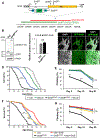Tau-Mediated Disruption of the Spliceosome Triggers Cryptic RNA Splicing and Neurodegeneration in Alzheimer's Disease
- PMID: 31597093
- PMCID: PMC6919331
- DOI: 10.1016/j.celrep.2019.08.104
Tau-Mediated Disruption of the Spliceosome Triggers Cryptic RNA Splicing and Neurodegeneration in Alzheimer's Disease
Abstract
In Alzheimer's disease (AD), spliceosomal proteins with critical roles in RNA processing aberrantly aggregate and mislocalize to Tau neurofibrillary tangles. We test the hypothesis that Tau-spliceosome interactions disrupt pre-mRNA splicing in AD. In human postmortem brain with AD pathology, Tau coimmunoprecipitates with spliceosomal components. In Drosophila, pan-neuronal Tau expression triggers reductions in multiple core and U1-specific spliceosomal proteins, and genetic disruption of these factors, including SmB, U1-70K, and U1A, enhances Tau-mediated neurodegeneration. We further show that loss of function in SmB, encoding a core spliceosomal protein, causes decreased survival, progressive locomotor impairment, and neuronal loss, independent of Tau toxicity. Lastly, RNA sequencing reveals a similar profile of mRNA splicing errors in SmB mutant and Tau transgenic flies, including intron retention and non-annotated cryptic splice junctions. In human brains, we confirm cryptic splicing errors in association with neurofibrillary tangle burden. Our results implicate spliceosome disruption and the resulting transcriptome perturbation in Tau-mediated neurodegeneration in AD.
Keywords: Alzheimer’s disease; RNA splicing; SmB; Tau; U1-70K; cryptic splicing; intron retention; neurodegeneration; neurofibrillary tangles; spliceosome.
Copyright © 2019 The Author(s). Published by Elsevier Inc. All rights reserved.
Conflict of interest statement
DECLARATION OF INTERESTS
The authors declare no competing interests.
Figures






References
-
- Andrews S (2010). FastQC: a quality control tool for high throughput sequence data.http://www.bioinformatics.babraham.ac.uk/projects/fastqc.
-
- Anne J (2010). Arginine methylation of SmB is required for Drosophila germ cell development. Development 137, 2819–2828. - PubMed
Publication types
MeSH terms
Substances
Grants and funding
- U01 AG046152/AG/NIA NIH HHS/United States
- R01 AG057339/AG/NIA NIH HHS/United States
- R01 GM120033/GM/NIGMS NIH HHS/United States
- R01 AG050631/AG/NIA NIH HHS/United States
- R01 AG053960/AG/NIA NIH HHS/United States
- U01 AG061357/AG/NIA NIH HHS/United States
- U01 AG046161/AG/NIA NIH HHS/United States
- R01 AG017917/AG/NIA NIH HHS/United States
- U54 HD083092/HD/NICHD NIH HHS/United States
- P30 AG010161/AG/NIA NIH HHS/United States
- P30 CA125123/CA/NCI NIH HHS/United States
- R01 AG036836/AG/NIA NIH HHS/United States
- R01 AG015819/AG/NIA NIH HHS/United States
LinkOut - more resources
Full Text Sources
Other Literature Sources
Medical
Molecular Biology Databases
Research Materials

